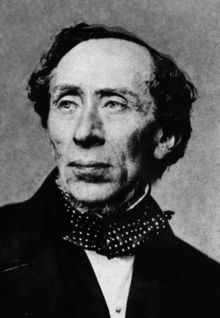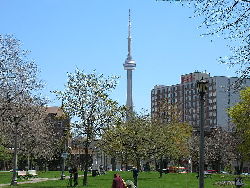The CN Tower, located in downtown Toronto, Ontario, Canada, is a communications and tourist tower standing 553.33 metres (1,815.39 ft) tall.[1] It surpassed the height of the Ostankino Tower while still under construction in 1975, becoming the tallest free-standing structure on land in the world. On September 12, 2007, after holding the record for 31 years, the CN tower was surpassed in height by the still-under-construction Burj Dubai.[2] It remains the tallest free-standing structure in the Americas and the signature icon of Toronto's skyline, attracting more than two million international visitors annually.[3]
CN originally referred to Canadian National, the railway company that built the tower. Following the railway's decision to divest non-core freight railway assets, prior to the company's privatization in 1995 it transferred the tower to the Canada Lands Company, a federal Crown corporation responsible for real estate development. Since local residents wished to retain the name CN Tower, the abbreviation is now said to expand to Canada's National Tower rather than the original Canadian National Tower; however, neither of these are commonly used.[4]
In 1995, the CN Tower was declared one of the modern Seven Wonders of the World by the American Society of Civil Engineers. It also belongs to the World Federation of Great Towers.
History
The concept of the CN Tower originated from a 1968 Canadian National Railway desire to build a large TV and radio communication platform to serve the Toronto area, as well as demonstrate the strength of Canadian industry and CN in particular. These plans evolved over the next few years, and the project became official in 1972. The tower would have been part of Metro Centre (see CityPlace), a large development south of Front Street on the Railway Lands, a large railway switching yard that was being made redundant by newer yards outside the city. Key project team members were NCK Engineering as structural engineer; John Andrews Architects; Webb, Zerafa, Menkes, Housden Architects; Foundation Building Construction; and Canron (Eastern Structural Division).
At the time, Toronto was a boom town, and the late 1960s and early 1970s had seen the construction of numerous large skyscrapers in the downtown core. This made broadcasting into the downtown area very difficult due to reflections off the buildings. The only solution would be to raise the antennas above the buildings, demanding a tower over 300 metres (984 ft) tall. Additionally, at the time, most data communications took place over point-to-point microwave links, whose dish antennae covered the roofs of large buildings. As each new skyscraper was added to the downtown, former line-of-sight links were no longer possible. CN intended to rent "hub" space for microwave links, visible from almost any building in the Toronto area. The CN Tower can be seen from at least as far away as Gamble Street in Richmond Hill, Ontario, approximately 30 kilometres (19 mi) to the north, and from several points on the south shore of Lake Ontario, 48 kilometres (30 mi) to the south.
The original plan for the tower envisioned a tripod consisting of three independent cylindrical "pillars" linked at various heights by structural bridges. Had it been built, this design would have been considerably shorter, with the metal antenna located roughly where the concrete section between the main level and the Sky Pod lies today. As the design effort continued, it evolved into the current design with a single continuous hexagonal core to the Sky Pod, with three support legs blended into the hexagon below the main level, forming a large Y-shape structure at the ground level.
The idea for the main level in its current form evolved around this time, but the Sky Pod was not part of the plans until some time later. One engineer in particular felt that visitors would feel the higher observation deck would be worth paying extra for, and the costs in terms of construction were not prohibitive. It was also some time around this point that it was realized that the tower could become the world's tallest structure, and plans were changed to incorporate subtle modifications throughout the structure to this end.
Construction
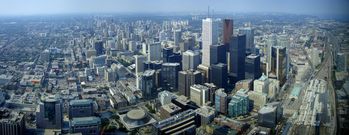

View of downtown Toronto from the CN Tower
Construction on the CN Tower began on February 6, 1973 with massive excavations at the tower base for the foundation. By the time the foundation was complete, 56,000 tonnes (61,729 ST) of dirt and shale were removed to a depth of 15 metres (49.2 ft) in the centre, and a base incorporating 7,000 cubic metres (9,156 cu yd) of concrete with 450 tonnes (496 ST) of rebar and 36 tonnes (40 ST) of steel cable had been built to a thickness of 6.7 metres (22 ft). This portion of the construction was fairly rapid, with only four months needed between the start and the foundation being ready for construction on top.
To build the main support pillar, a hydraulically-raised slipform was built at the base. This was a fairly impressive engineering feat on its own, consisting of a large metal platform that raised itself on jacks at about 6 metres (19.7 ft) per day as the concrete below set. Concrete was poured continuously by a team of 1,532 people until February 22, 1974, during which it had already become the tallest structure in Canada, surpassing the recently built Inco Superstack, which was built using similar methods. In total, the tower contains 40,500 cubic metres (52,972 cu yd) of concrete, all of which was mixed on-site in order to ensure batch consistency. Through the pour, the vertical accuracy of the tower was maintained by comparing the slip form's location to massive plumb-bobs hanging from it, observed by small telescopes from the ground. Over the height of the tower, it varies from true vertical accuracy by only 29 millimetres (1.1 in).
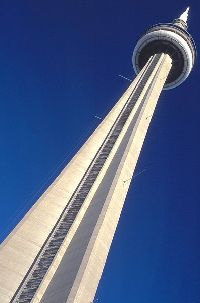

The CN Tower as seen from its base
In August 1974, construction of the main level commenced. Using 45 hydraulic jacks attached to cables strung from a temporary steel crown anchored to the top of the tower, twelve giant steel and wooden bracket forms were slowly raised, ultimately taking about a week to crawl up to their final position. These forms were used to create the brackets that support the main level, as well as a base for the construction of the main level itself. The Sky Pod was built of concrete poured into a wooden frame attached to rebar at the lower level deck, and then reinforced with a large steel compression band around the outside.
The antenna was originally to be raised by crane as well, but during construction the Sikorsky S-64 Skycrane helicopter became available when the United States Army sold off theirs to civilian operators. The helicopter, named "Olga", was first used to remove the crane, and then flew the antenna up in 36 sections. The flights of the antenna pieces were a minor tourist attraction of their own, and the schedule was printed in the local newspapers. Use of the helicopter saved months of construction time, with this phase taking only three and a half weeks instead of the planned six months. The tower was topped off on April 2, 1975 after 26 months of construction, officially capturing the height record from Moscow's Ostankino Tower, and bringing the total mass to 118,000 tonnes (130,073 tons).
Two years into the construction, plans for Metro Centre were scrapped, leaving the tower isolated on the Railway Lands in what was then a largely abandoned light-industrial space. This caused serious problems for tourists to access the tower. Ned Baldwin, project architect with John Andrews, wrote at the time that "All of the logic which dictated the design of the lower accommodation has been upset," and that "Under such ludicrous circumstances Canadian National would hardly have chosen this location to build."
Opening
The CN Tower opened to the public on June 26, 1976, although the official opening date was October 1. The construction costs of approximately CDN$63 million ($330 million in 2005) were repaid in fifteen years. Canadian National Railway sold the tower prior to taking the company public in 1995, when they decided to divest themselves of all operations not directly related to their core freight shipping businesses.
As the area around the tower was developed, particularly with the introduction of the Metro Toronto Convention Centre and Rogers Centre (known as the SkyDome before 2005), the former railway "wasteland" disappeared and the tower became the centre of a newly developing entertainment area. Access was greatly improved with the construction of the SkyWalk in 1989, which connected the tower and SkyDome to the nearby railway and subway station, Union Station. By the mid-1990s, it was the centre of a thriving tourist district. The entire area continues to be an area of intense building, notably a boom in condominium construction in the 2000s.
From 1997 to January 2004, TrizecHahn Corporation managed the building and instituted several expansion projects including a $26 million entertainment expansion and revitalization that included the addition of two new elevators (to a total of six) and the relocation of the staircase from the north side leg to inside the core of the building, a conversion that also added nine stairs to the climb.
Structure
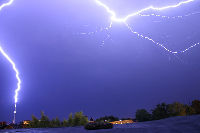

A bolt of lightning strikes the CN Tower. The CN Tower is struck by lightning at least 40 to 50 times annually compared to other places in
Toronto which are struck, on average, 2 times per
square kilometre (5 times per sq mi) every year.
[5] The CN Tower consists of several substructures. The main portion of the tower is a hollow concrete hexagonal pillar containing the six elevators, stairwells, and power and plumbing connections. On top of this is a 102 metres (334.6 ft) metal broadcast antenna, carrying TV and radio signals. There are two visitor areas: the main deck level (formerly known as SkyPod) located at 346 metres (1,135 ft), and the higher Sky Pod (formerly known as "Space Deck) at 446.5 metres (1,465 ft),[6] just below the metal antenna. The hexagonal shape can be seen between the two areas; however, below the main deck, three large supporting legs give the tower the appearance of a large tripod.
The main level is seven stories, some of which are open to the public. Below the public areas — at 338 metres (1,108.9 ft) — is a large white donut-shaped radome containing the structure's microwave receivers. The glass floor and outdoor observation deck are at 342 metres (1,122.0 ft). The glass floor has an area of 24 square metres (258 sq ft) and can withstand a pressure of 4,100 kilopascals (595 psi). The floor's thermal glass units are 64 millimetres (2.5 in) thick, consisting of a pane of 25-millimetre (1.0 in) laminated glass, 25 millimetres (1.0 in) airspace and a pane of 13-millimetre (0.5 in) laminated glass. Some people experience acrophobia when standing on the glass floor and looking down at the ground 342 metres (1,122.0 ft) below. In 2008, one elevator was upgraded to add a glass floor panel, believed to have the highest vertical rise of any elevator so equipped.[7] The Horizons Cafe and the lookout level are at 346 metres (1,135.2 ft). The 360 Restaurant, a revolving restaurant that completes a full rotation once every 72 minutes, is at 351 metres (1,151.6 ft). When the tower first opened, it also featured a disco named Sparkles, billed as the highest disco and dance floor in the world.
The Sky Pod is the highest public observation deck in the world. On a clear day, it is possible to see 100 to 120 kilometres (62–75 mi) away, to the city of Rochester across Lake Ontario in the United States, the mist rising from Niagara Falls, or the shores of Lake Simcoe.
A metal staircase reaches the main deck level after 1,776 steps,[8] and the Sky Pod 100 metres above after 2,579 steps; it is the tallest metal staircase on Earth. These stairs are intended for emergency use only and are not open to the public, except for three times per year for charity stair-climb events.[9][10] The average climber takes approximately 30 minutes to climb to the base of the radome, but the fastest climb on record is 7 minutes and 52 seconds in 1989 by Brendan Keenoy, an Ontario Provincial Police Officer.[10] In 2002, Canadian Olympian and Paralympic champion Jeff Adams climbed the stairs of the tower in a specially designed wheelchair.[8]
Falling Ice Danger
A freezing rain storm on March 2, 2007 resulted in a layer of ice several centimetres thick forming on the side of the tower and other downtown buildings. The sun thawed the ice, and winds of up to 90 kilometres per hour (56 mph) blew some of it away from the structure. There were fears that cars and windows of nearby buildings would be smashed by large chunks of ice. In response, police closed some streets surrounding the tower. During morning rush hour on March 5, police expanded the area of closed streets to include the Gardiner Expressway 310 metres (1,017 ft) away from the tower, as increased winds blew the ice farther away, as far north as King Street, 490 metres (1,608 ft) away, where a taxicab window was shattered.
On March 6, the Gardiner Expressway was reopened after winds died down.[11] It was the first time such an event had posed a threat to public safety.
Safety features
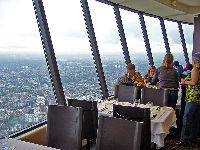

Inside the 360 Restaurant in the CN Tower
In August 2000, a fire broke out at the Ostankino Tower in Moscow, killing several people and causing extensive damage. The fire was blamed on poor maintenance and outdated equipment. The failure of the fire-suppression systems and the lack of proper equipment for firefighters allowed the fire to destroy most of the interior and spark fears the tower might even collapse.
The Ostankino Tower was built 9 years before the CN Tower and is only 13 metres shorter. However, Canadian officials subsequently stated that it is "highly unlikely" that a similar disaster could occur at the CN Tower as it has safeguards that were not present in the Ostankino Tower. Specifically, officials cited:
- the fireproof building materials used in the tower's construction,
- frequent and stringent safety inspections,
- an extensive sprinkler system,
- a 24-hour emergency monitoring operation,
- two 15,000-imperial gallon water reservoirs at the top which are automatically replenished,
- a fire hose at the base of the structure capable of sending 600 imperial gallons a minute to any location in the tower,
- a ban on gas appliances anywhere in the tower,
- an elevator that can be used during a fire as it runs up the outside of the building and can be powered by three emergency generators at the base of the structure (unlike the elevator at the Ostankino tower, which seriously malfunctioned).[12]
Officials also noted that the CN Tower has an excellent safety record and that there has never been accidental fire in the tower since it was opened in 1976.[12] Moreover, other tall structures built between 1967–1976, such as the Sears Tower, the World Trade Center (excluding the terrorist attacks), the John Hancock Center, and the Aon Center also have excellent safety records, which suggests that the Ostankino Tower fire was a rare safety failure.
Lighting


The CN Tower illuminated, as seen from downtown Toronto
The CN Tower was once lit at night with incandescent lights, but they were removed in 1997 because they were expensive and inefficient to repair. In June 2007, the tower was outfitted with 1,330 super-bright LED lights inside the elevator shafts, shooting up over the "bubble" and upward to the top of the tower's mast to light the tower from dusk until 2 a.m. The official opening ceremony took place on June 28 before the Canada Day holiday weekend. After the 95th Grey Cup in Toronto, the tower was lit up in green and white to represent the colours of the Grey Cup champion Saskatchewan Roughriders.[13]
Programmed from a desktop computer with a wireless network interface card, the LEDs use less energy to light than the previously used incandescent lights (10% less energy than the dimly lit version and 60% less than the brightly lit version). The estimated cost to use the LEDs is $1,000 per month.
During the spring and autumn bird migration seasons, the lights will be turned off to comply with the voluntary Fatal Light Awareness Program, which "encourages buildings to dim unnecessary exterior lighting to mitigate bird mortality during spring and summer migration."[14]
Size comparisons
-
Comparisons to other notable structures
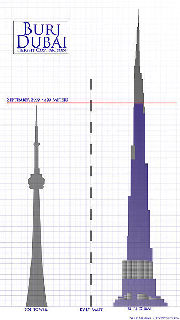

The CN Tower's height compared to that of the
Burj Dubai in September 2007
The CN Tower is approximately:
There are currently six proposals for towers whose final heights are to exceed the CN Tower's,[15] four of which are currently under construction. At the forefront is the Burj Dubai which surpassed the CN Tower in height in September 2007. The developers of Burj Dubai have kept the final planned height and number of stories a secret, but they have announced that it would stop somewhere above 2,684 feet (818.1 m). In North America, the Chicago Spire's height is currently planned to exceed CN Tower's height, currently planned at 2,000 feet (609.6 m).[16] The Freedom Tower, which is under construction in New York City, is expected to be 12 m (39 ft) shorter in order to make the tower 1776 feet tall (1776 being the year that the United States declared independence).
Two other structures, the Russia Tower being built in Moscow, Russia, and the Guangzhou TV & Sightseeing Tower, being built in Guangzhou, China, are also expected to be taller that the CN Tower when completed, with the structures having expected final heights of 612 m (2,008 ft) and 610 m (2,001 ft), respectively.
Controversy over the "world's tallest" title
Guinness World Records has called the CN Tower "the world's tallest self-supporting tower" and "the world's tallest free-standing tower".[17][18] Although Guinness did list this description of the CN Tower under the heading "tallest building" at least once,[18] it has also listed it under "tallest tower", omitting it from its list of "tallest buildings."[17] In 1996, Guinness officially changed the tower's classification to "World's Tallest Building and Freestanding Structure". Today, Guinness state that the CN Tower is the "Tallest Freestanding Tower," because the Petronius Platform oil platform in the Gulf of Mexico is taller at 2,001 feet (609.9 m), yet most of the rig is underwater, earning it the title of tallest free-standing structure in the world. Emporis and the Council on Tall Buildings and Urban Habitat both list the CN Tower as the world's tallest free-standing structure on land, and specifically state that the CN Tower is not a true building, thereby awarding the title of world's tallest building to Taipei 101, which is 44 metres (144 ft) shorter than the CN Tower.[19][20] The tower's official web site, however, unequivocally claims it is the "world's tallest building".[21]
Although the CN Tower contains a restaurant, a gift shop, and multiple observation levels, it does not have floors continuously from the ground, and therefore it is not considered a building by the Council on Tall Buildings and Urban Habitat (CTBUH), Emporis, or any other architectural authorities. CTBUH defines a building as "a structure that is designed for residential, business, or manufacturing purposes. An essential characteristic of a building is that it has floors."[20] The CN Tower and other similar structures, such as the Ostankino Tower in Moscow, Russia, the Stratosphere Tower in Las Vegas, Nevada, and the Eiffel Tower in Paris, France are categorized as "towers", which are free-standing structures that may have observation decks and a few other habitable levels, but do not have floors from the ground up. The CN Tower is the tallest tower by this definition.[19]
Taller than the CN Tower are numerous radio masts and towers which are held in place by guy-wires, the tallest being the KVLY-TV mast in North Dakota at 628 metres (2,060 ft) tall, leading to a distinction between these and "free-standing" structures. Additionally, the Petronius Platform stands 610 metres (2,001 ft) above its base on the bottom of the Gulf of Mexico, but only the top 75 metres (246 ft) of this oil and natural gas platform are above water, and the structure is thus partially supported by its buoyancy. Like the CN Tower, none of these taller structures are commonly considered buildings.
On September 12, 2007, the Burj Dubai, a hotel, residential and commercial building being built in Dubai, United Arab Emirates, passed the CN Tower's 553.33 metre[1] height. The CN Tower held the record of tallest free-standing structure on land for over 30 years.[2] The tower now stands as the second-tallest free-standing structure on land in the world, and as the tallest completed structure.
Use
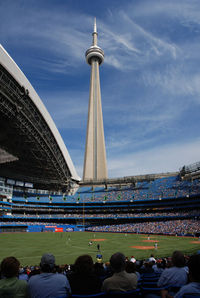

The CN Tower as seen from the interior of the
Rogers Centre stadium
The CN Tower has been and continues to be used as a communications tower for a number of different media, and by numerous companies.
Television broadcasters
Radio
There is no AM broadcasting on the CN Tower.[22] The FM antennas are situated 421 metres (1,381 ft) above ground.
| Callsign[23] | Frequency | ERP | Branding | Notes |
| Master FM | Consortium of Toronto broadcasters for Digital Audio Broadcasting |
| CJRT | 91.1 MHz | 40 kW | JAZZ.FM91 | |
| CJAQ | 92.5 MHz | 40 kW | 92.5 Jack FM | |
| CBL | 94.1 MHz | 38 kW | CBC Radio 2 | |
| CFMZ | 96.3 MHz | 38 kW | Classical 96 | |
| CJEZ | 97.3 MHz | 4 kW | EZ Rock 97.3 | |
| CHFI | 98.1 MHz | 44 kW | 98.1 CHFI | |
| CKFM | 99.9 MHz | 40 kW | 99.9 Mix FM | |
| CHIN | 100.7 MHz | 4 kW | CHIN Radio | Primarily in Italian and Portuguese |
| CFNY | 102.1 MHz | 35 kW actual (100 kW ERP) | 102.1 the Edge |
| CHUM | 104.5 MHz | 40 kW | 104.5 CHUM FM | |
| CILQ | 107.1 MHz | 40 kW | Classic Rock Q 107 | |
Cellular and paging providers
Communications
Media placement
